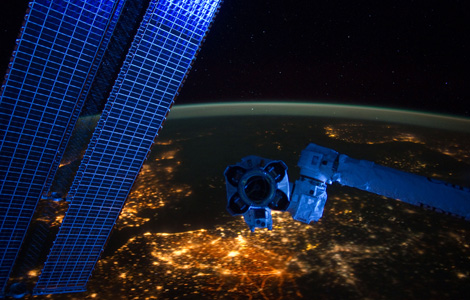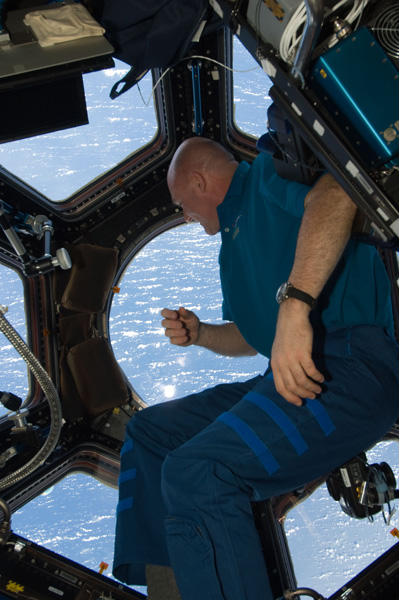The World Through a Looking Glass
From orbit, the more you know about our planet, the more you can see
Looking through the cupola windows on Space Station, it’s only natural to reflect upon who we are and where we fit into the world below. Like something out of Alice in Wonderland, this orbital looking glass can be both a window through which to observe the jeweled sphere of Earth and a mirror that (sometimes, depending on your viewing angle) shows you a translucent reflection of yourself superimposed on the planet.
From orbit, the more you know about our planet, the more you can see. You see all the geological features described in textbooks. You see fault zones, moraines, basins, ranges, impact craters, dikes, sills, braided channels, the strike and dip of layered rocks, folding, meanders, oxbow lakes, slumps, slides, mud flows, deltas, alluvial fans, glaciers, karst topography, cirques, tectonic plates, rifts zones, cinder cones, crater lakes, fossil sea shores, lava flows, volcanic plumes, fissures, eruptions, dry lakes, inverted topography, latteric soils, and many more.
You see clouds of every description and combination: nimbus, cumulus, stratus, nimbo-cumulus, nimbo-stratus, cirrus, thunderheads, and typhoons, sometimes with clockwise rotation, sometimes with counter-clockwise. You notice patterns: clouds over cold oceans look different than clouds over warm oceans. Sometimes the continents are all cloud-covered, so you have no recognizable landmass to help you gauge where you are. If you see a crisscross of jet contrails glistening in the sun above the clouds, you know you are over the United States.
Lightning storms flash like gigantic fireflies looking for mates half a continent away. You see patterns on the ocean surface, swirls and vortices on large scales, wave diffraction patterns around capes, solitary waves forming long lines out in the middle of nowhere, and rivers that look like they are spilling milk chocolate into turquoise oceans.
You see light-scattering phenomena of all kinds—at sunrise, at sunset, across the terminator, 16 times a day. You see crepuscular rays, forward reddened lobes, off-axis blue lobes, and corona halos. With binoculars you can count six distinct layers in the atmosphere, with the outer one seemingly fading into fuzzy blackness.
The aurora is nothing short of occipital ecstasy. It is always moving, always changing, and like snowflakes, no two displays are the same. The glowing red and green forms meander like celestial amoebas crawling across some great petri dish. One time our orbit took us through the center of an auroral display. It was as if we were in a glowing fog of red and green. Had we been shrunk down and inserted into the tube of a neon sign? It looked like it was just on the other side of the windowpane. I wanted to reach out and touch, but of course I couldn’t. Afterwards, I had to clean nose prints off of the window.
You catch an occasional meteor while looking down at Earth. You see stars and planets in oblique views, next to Earth’s limb. And they do not twinkle. Perchance you might spot a ragged shadow from a total solar eclipse projected onto Earth. Amazing, it looks just like it does in the textbooks! You have a godlike view of the finer details of shadowy projections onto spherical bodies. You see space junk orbiting nearby. Sometimes it flickers due to an irregularity, catching light as it rotates. An overboard water dump produces a virtual blizzard in the surrounding vacuum. Like strangers passing in the night, you see other satellites flash brilliantly for a few seconds, then fade into oblivion.
Jungles are the darkest land features you can observe in full sunlight. They are so dark that you need to open your camera lens to obtain a proper exposure. If there are clouds partly shrouding your view, you can be fooled into thinking you are over the ocean. Only when you notice rivers with braided channels and meandering loops of chocolate brown do you realize that it is jungle and not water. Farmland, rich with vibrant crops, is different. Farmland is bright, much brighter than the jungles. Here nature is giving us a clue as to the efficiency of light capture by plants.
The impact of humanity on Earth is humbling from orbit. Our greatest cities appear to the bare eye as minor gray smudges on the edges of continents—they could be the fingerprints of Atlas, from the last time he handled the globe. They are hardly distinguishable from volcanic ash flow or other geologic features. If you didn’t know it was a city, it would be difficult to conclude it was the result of human design. Under the scrutiny of the telephoto lens, things appear different. Like ants moving crumbs of dirt, we are slowly changing our world. You realize that Earth will do just fine, with or without us. We are wedded to this planet, for better or for worse, until mass extinction do us part.
Cities at night are different from their drab daytime counterparts. They present a most spectacular display that rivals a Broadway marquee. And cities around the world are different. Some show blue-green, while others show yellow-orange. Some have rectangular grids, while others look like a fractal-snapshot from Mandelbrot space.
Patterns in the countryside are different in Europe, North America, and South America. In space, you can see political boundaries that show up only at night. As if a beacon for humanity, Las Vegas is truly the brightest spot on Earth. Cities at night may very well be the most beautiful unintentional consequence of human activity.
This looking glass incites your mind to ponder the abstract. Through the window, you explore the world. In the mirror, you reflect upon your place within it and the reasons we explore. Is it fundamentally about finding new places to live and new resources to use? Or is it about expanding our knowledge of the universe? Either way, exploration seems fundamental to our survival as a species. After all, if the dinosaurs had explored space and colonized other planets, they would still be alive today.

